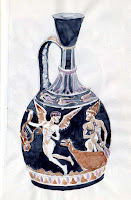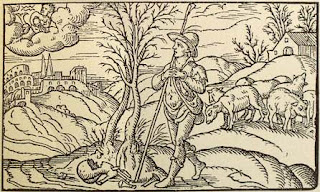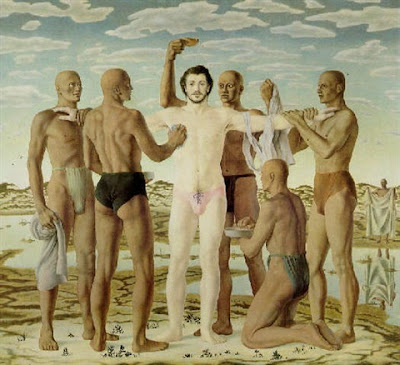Orpheus in the Bronx by Reginald Shepherd.
Orpheus in the Bronx, (University of Michigan Press, 2007) is the poetic title of Reginald Shepherd’s new book of essays. It is a fine title, one that aligns clearly with a number of essays in this collection: “To make me who I am”, an autobiographical essay about poetry and the Bronx; “Toward an Urban Pastoral", which concerns itself with the poetry and the city—the city as metaphor within the poetic imagination.
Without question, these are rich and intelligent essays, some of which are fixed forms of posts from Reginald Shepherd’s poetry blog. “The Other’s Other” is a thought-provoking reflection upon the author’s dislike of identity politics. Orpheus in the Bronx is sub-titled “Essays on Identity, Politics, and the Freedom of Poetry”. The , between Identity and Politics suggests that a third of this volume is concerned with politics. Not so. Politics, here, equals, polis, of the city, and is bound up with Identity Politics and how a poet might affirm his creative freedom (against the pressures of group demands) to live within the real city and the city of imagination.
Reginald Shepherd’s opposition to identity politics (and its gravitational pull towards the agendas of others) has sometimes seemed like a denial of identity: it has allowed some critics to read his work as distanced and complicated rather than approachable and complex. So, it is interesting that this volume opens with a beautifully paced autobiography of how a young (gay, Black) man grew against hostile educational pressures. Reading this essay, the work of Kenneth and Mamie Clark came frequently to mind. Their Northside Centre, in Harlem, began to investigate psychological disturbances amidst Black youngsters. Their focus eventually turned towards literacy issues: psychological distress, they found, was rooted in literacy, the inability to be empowered by language. The theme which emerges again and again in Reginald Shepherd’s essay is this exactly. Orpheus is the energy that lifts him up, word and books are the power to survive. The first essay establishes what can be heard in his latest poems from Fata Morgana, in poems such as “Orpheus Plays the Bronx” and “A Handful of Sand”, namely, a warm and questioning intelligence.
Orpheus in the Bronx, is divided into four sections: “Portrait of the Artist”, “Manifestos of a Sort”, “Readings” and “A Poetics”. It will be true, I guess, that different readers will find different qualities in each section. Certainly, “To Make Me Who I am”, which is “Portrait of the Artist”, is affirmative and significant. From “Manifestos of a Sort”, “The Other’s Other” and “Toward an Urban Pastoral” are provocative and incisive pieces of writing. All of the six essays in “Readings” are interesting, though for me, “Shadows and Light Moving on Water” is more a collection of notes than an essay. And “On Jorie Graham’s Erosion”, though full of insights, can be frustrating at times. Sometimes, demonstrations are like reading rubbed out hieroglyphics. For example: “Graham’s poem [“Kimono”] does not acknowledge the necessity or even the possibility of distinguishing between what Hopkins calls the [?] “the true and the false instress of nature” (OINB, p.101). Instress and Inscape, in Hopkins, are complex terms, meaning something like Buber’s I-Thou, or Shelley’s experiments with Platonic synaesthesia and Ideal Form, or Pound’s Eleusininan Vortex in The Cantos, and this kind of abbreviated argument is hard to comprehend. The essay which really sings in this section is 'On Alvin Feinman’s “True Night”'. It is affectionate, empathetic and beautifully cadenced. The final section of essays pursues the purpose of poetry: first, in the abstract, by viewing Wallace Stevens and Yeats; second, in the concrete, by considering why Reginald Shepherd writes poetry.
 Orpheus in the Bronx is a very important collection of essays. Reginald Shepherd draws upon a wide reading of poets to expand his thoughts. Of course, this is challenging, but it is also truthful for Reginald Shepherd believes in truth-telling and is aware (unlike some poets today) that the American muse did not spring by parthogenesis from the head of Whitman or a seminal clot in the brain of Olson. You don’t have to be Gay to want to read this volume. You don’t have to be Black to enjoy it. You don’t have to be a Poet to follow it. You do, however, have to be human and in love with words, which is probably as life should be! Reading this collection is like turning around a Greek vase and discovering the many interlinked faces of a mythic (his)story.
Orpheus in the Bronx is a very important collection of essays. Reginald Shepherd draws upon a wide reading of poets to expand his thoughts. Of course, this is challenging, but it is also truthful for Reginald Shepherd believes in truth-telling and is aware (unlike some poets today) that the American muse did not spring by parthogenesis from the head of Whitman or a seminal clot in the brain of Olson. You don’t have to be Gay to want to read this volume. You don’t have to be Black to enjoy it. You don’t have to be a Poet to follow it. You do, however, have to be human and in love with words, which is probably as life should be! Reading this collection is like turning around a Greek vase and discovering the many interlinked faces of a mythic (his)story.
Without question, these are rich and intelligent essays, some of which are fixed forms of posts from Reginald Shepherd’s poetry blog. “The Other’s Other” is a thought-provoking reflection upon the author’s dislike of identity politics. Orpheus in the Bronx is sub-titled “Essays on Identity, Politics, and the Freedom of Poetry”. The , between Identity and Politics suggests that a third of this volume is concerned with politics. Not so. Politics, here, equals, polis, of the city, and is bound up with Identity Politics and how a poet might affirm his creative freedom (against the pressures of group demands) to live within the real city and the city of imagination.
Reginald Shepherd’s opposition to identity politics (and its gravitational pull towards the agendas of others) has sometimes seemed like a denial of identity: it has allowed some critics to read his work as distanced and complicated rather than approachable and complex. So, it is interesting that this volume opens with a beautifully paced autobiography of how a young (gay, Black) man grew against hostile educational pressures. Reading this essay, the work of Kenneth and Mamie Clark came frequently to mind. Their Northside Centre, in Harlem, began to investigate psychological disturbances amidst Black youngsters. Their focus eventually turned towards literacy issues: psychological distress, they found, was rooted in literacy, the inability to be empowered by language. The theme which emerges again and again in Reginald Shepherd’s essay is this exactly. Orpheus is the energy that lifts him up, word and books are the power to survive. The first essay establishes what can be heard in his latest poems from Fata Morgana, in poems such as “Orpheus Plays the Bronx” and “A Handful of Sand”, namely, a warm and questioning intelligence.
Orpheus in the Bronx, is divided into four sections: “Portrait of the Artist”, “Manifestos of a Sort”, “Readings” and “A Poetics”. It will be true, I guess, that different readers will find different qualities in each section. Certainly, “To Make Me Who I am”, which is “Portrait of the Artist”, is affirmative and significant. From “Manifestos of a Sort”, “The Other’s Other” and “Toward an Urban Pastoral” are provocative and incisive pieces of writing. All of the six essays in “Readings” are interesting, though for me, “Shadows and Light Moving on Water” is more a collection of notes than an essay. And “On Jorie Graham’s Erosion”, though full of insights, can be frustrating at times. Sometimes, demonstrations are like reading rubbed out hieroglyphics. For example: “Graham’s poem [“Kimono”] does not acknowledge the necessity or even the possibility of distinguishing between what Hopkins calls the [?] “the true and the false instress of nature” (OINB, p.101). Instress and Inscape, in Hopkins, are complex terms, meaning something like Buber’s I-Thou, or Shelley’s experiments with Platonic synaesthesia and Ideal Form, or Pound’s Eleusininan Vortex in The Cantos, and this kind of abbreviated argument is hard to comprehend. The essay which really sings in this section is 'On Alvin Feinman’s “True Night”'. It is affectionate, empathetic and beautifully cadenced. The final section of essays pursues the purpose of poetry: first, in the abstract, by viewing Wallace Stevens and Yeats; second, in the concrete, by considering why Reginald Shepherd writes poetry.
 Orpheus in the Bronx is a very important collection of essays. Reginald Shepherd draws upon a wide reading of poets to expand his thoughts. Of course, this is challenging, but it is also truthful for Reginald Shepherd believes in truth-telling and is aware (unlike some poets today) that the American muse did not spring by parthogenesis from the head of Whitman or a seminal clot in the brain of Olson. You don’t have to be Gay to want to read this volume. You don’t have to be Black to enjoy it. You don’t have to be a Poet to follow it. You do, however, have to be human and in love with words, which is probably as life should be! Reading this collection is like turning around a Greek vase and discovering the many interlinked faces of a mythic (his)story.
Orpheus in the Bronx is a very important collection of essays. Reginald Shepherd draws upon a wide reading of poets to expand his thoughts. Of course, this is challenging, but it is also truthful for Reginald Shepherd believes in truth-telling and is aware (unlike some poets today) that the American muse did not spring by parthogenesis from the head of Whitman or a seminal clot in the brain of Olson. You don’t have to be Gay to want to read this volume. You don’t have to be Black to enjoy it. You don’t have to be a Poet to follow it. You do, however, have to be human and in love with words, which is probably as life should be! Reading this collection is like turning around a Greek vase and discovering the many interlinked faces of a mythic (his)story.



Comments